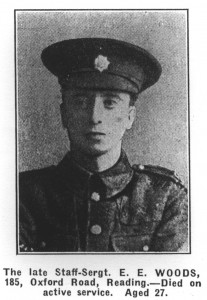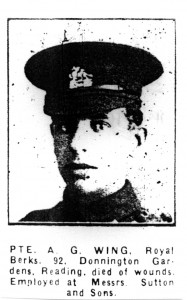Charles Edward Wilson
Captain 1st Battalion
Queens Royal West Surrey Regiment
Division 60
 |
Charles Edward Wilson is commemorated on his wife’s grave in the old Reading Cemetery. He was the first soldier commemorated in the cemetery to die during the Great War.
Charles Wilson was born in Cork, Ireland, on 2 June 1871, the son of Major General Francis E Wilson; Charles was also to be a career soldier. His association with Reading began on 31 December 1896 when at the age of 25, he married Mabel Carr, the daughter of Colonel George Sydney Carr, at St Mary’s Church.
Their first child Edward Sydney Wilson was born in Reading on 1 October 1897. Records show that he was baptised the following day and the headstone on his mother’s grave shows that he had died ten days later. A second son, Hugh Edward Wilson was born in October 1904. Sadly, Mable died at some time before the 1911 census; her headstone does not record the date of her death and it has not been possible to establish a date or cause of death for Mable by other means. The 1911 census records Charles as widowed and living at the Stoughton Barracks, Guilford. He was then 39 and holding the rank of Captain in his regiment. 1911 census record show that Hugh, then aged 6 was living with his widowed maternal grandmother Rose Carr at 7. Maitland Road, Reading. Rose was then age 61 and was assisted in the rearing of Hugh by a governess, a cook and a maid.
Captain Wilson served in South Africa during the Boer War and it is also thought that he served in India. During his career he was decorated several times and we are told that he received the ‘Légion d’Honneur’ after his death in 1914. A detailed article, posted by an ancestor, about Captain Wilson’s life as a career soldier and Rugby player can be found in Wikipedia.
As a soldier in the regular army Captain Wilson and member of the BEF, the British Expeditionary Force, he was quickly involved in the opening battles of the war. His battalion fought at Mons and various actions during the retreat to the Marne. A counter offensive was launched on the 5 September by both the French and British armies which allowed them to reach the River Aisne on 13 September. At that point the Allies progress was checked y the German Army and fierce fighting took place on the slopes of the Chemin De Dames. The first trenches of the war were dug here on the 14 September 1914. The Queens Royal West Surrey 1st Battalion War Diary indicates that there was heavy shelling by the Germans which resulted in a high casualty rate. The 16 September saw intermittent sniping fire throughout the day and a heavy bombardment between 4.30 and 6.30 p.m. On 17 September shelling was heavy throughout the day and it was during this action that Captain Wilson and the battalion Commanding Officer Lieutenant Colonel D. Warren were killed. Shelling continued throughout the following day with the men relying heavily on the protection of the trenches. The battalion was engaged in fighting throughout the remainder of September and early October before moving into Belgium where they were then engaged in the 1st Battle of Ypres on the 21 September. This history of the battalion records that by the end of the first week of November 1914, there were only thirty-two survivors out of the original 998 men who had left England with the 1st Battalion Queens Royal West Surrey Regiment at the onset of the war.
Captain Charles Edward Wilson was killed in action on the 17th September 1914. He is buried in Paissy Church Yard, Aisne. Grave 2.


